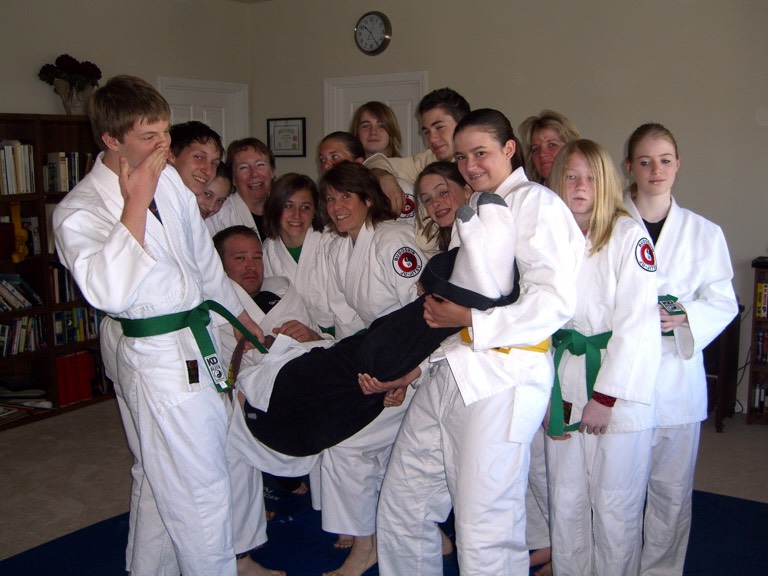Jujitsu is dangerous...
You can (and we emphatically do) minimize the risk, but you can’t get around the danger part. The full toolset of self-defense -- and realistic means to learn how to utilize it -- requires hands-on involvement with more than three or four Uke (that is, partners who serve as attackers for learning purposes), so you develop a reflexive ability to deal with different body-types. You can’t learn how to deal with a large attacker by practicing with air. Neither can you deal with an attacker by using your cerebral cortex - you MUST develop reflexive moves, “muscle memory” if you will, and this is a purely hands-on, repetitive endeavor.
Because Jujitsu is so hands-on, you can imagine that without some stringent safety protocols you would very soon run out of Uke to practice with. For this very reason Judo evolved over a century ago to be a safe-to-practice subset of Jujitsu - a sport - where you could repeatedly practice certain moves and be reasonably assured you wouldn’t inadvertently kill your Uke. Likewise, modern Karate is a subset of Jujitsu. In Karate practice, kumite (free fighting) is infrequent - close physical combat with all its inherent injuries is mainly a rare validation process in most styles, normally involving heavy padding. Most Karate practice involves blocks, punches, and kicks done against the air; these are either arranged kumite or kata - the latter word is used in Karate for the ritualized, stylized combat dances most of us are familiar with. (Note that “Kata” in Jujitsu refers to an individual submission or hands-on control technique.) The theory behind Karate kata is that if you practice them a thousand times, the moves will come to you when you need them. Unfortunately, punching the air is very different from the physical dynamics necessary to punch a human cheekbone - and both are quite different from punching a Makiwara (the coarse-cloth-covered flexible punching board you will see in very traditional karate schools).
A very small number of people in this world can actually take the World Fighting Championships-style heavy battering in unconstrained kumite (free-fight), and seem to love it. A few people even seem to be built for it - however, you don’t see many people over the age of 35 doing this... and you can easily guess why Most of us can’t take this sort of battering - so Jujitsu is self defense for the rest of us. It really works, too - but the ancillary consequence of dealing with something so effective is that it’s also dangerous. For this reason reputable Jujitsu instructors therefor teach Jujitsu as a defensive martial art. There are some who don’t, but instead try to teach it as a macho, testosterone-driven attack art - you can imagine the injuries this entails and and you can probably guess what Budoshin Jujitsu Senseis might think about this.
...and stringent safety protocols are the key.
“The rules that ensure your long-term viability as a Jujitsu practitioner” include:
- No practice, even informal, should take place in the dojo without the direct and watchful supervision of a brown belt student or higher. Ideally, there should be a closely-watching supervisor for every practicing pair “going at it” on the mat.
- Except for very advanced students (brown belt and above), everything must be done at quarter speed. This ensures that a dynamic submit” doesn’t happen - a hyper-extension of an elbow or knee or other joint. Quarter speed allows novice students to develop smooth and efficient technique - without learning bad habits - and when Your Worst Nightmare occurs, the adrenaline will lead to a natural ramping up of speed - but with surprisingly smooth and effective application.
- Fingernails and toenails should be cut very short - or taped. All jewelry should be removed - or taped.
- When practicing, keep your mouth shut except to kiai. This saves tongues. When taking a fall, you must always kiai to protect your own chest and lungs and minimize the possibility of self-injury.
- Don’t complain when your sensei urges you to practice, and practice, and practice Ukemi. Learning how to reflexively fall is your ultimate protection, as 85% - 90% of all upright hand-to-hand combat statistically ends up on the ground. This statistic helps you to understand why Brazilian Jujitsu, for instance, emphasizes ground-techniques and grappling… and deliberately trying to get there as soon as possible.
- Men should consider wearing an athletic cup. This could be a quick self-taught lesson.
- If you wear braces, we STRONGLY recommend using a mouth-guard.
- If you have a cold or other illness, do not come to the dojo out of courtesy to your fellow students. When you come to class, liberally use the hand-disinfectant your Sensei provides you. Help clean the mats with disinfectant after class.
- If you feel some pain that persists more than a few seconds beyond a “submit” - inform your Sensei immediately. Repeated hyper-extensions of joints can lead to cumulative injuries. There is relatively little lost by attending class and watching for a few weeks, or participating but avoiding any activity that would involve a sore joint.
Even sitting, you can still learn much from every class. There is a whole suite of powerful defensive techniques executed from a sitting position.
Follow these rules and you will be safe...

…And your Uke will be re-usable (in that sense we are a “green dojo”)! Students: “You may have a black belt, but there are 16 of US!!”